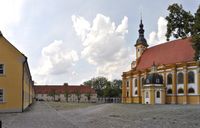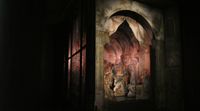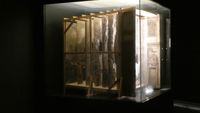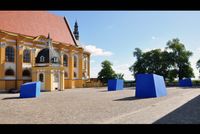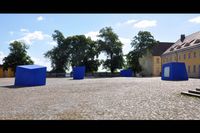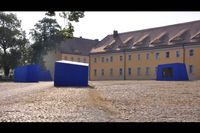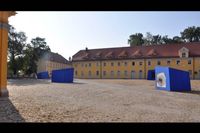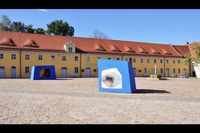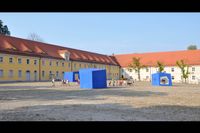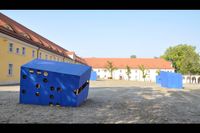UTOPIE PASSION
Eine temporäre Installation auf dem Stiftsplatz des Kloster Neuzelle
30. Juni bis 1. September 2019
mit Projekten von Alexandra Hopf, Tamara KE, Armin Hartenstein und Michael Hofstetter
und Tisch- und Gesprächsrunden mit verschiedenen Gästen, u.a., als Experten:
Sabine Sanio, Sven Spieker, Georg Imdahl, Guillaume Paoli
Ausstellungsarchitektur und Kuration / Exhibition architecture and curation: Niklas Nitschke
(scroll down for english version)
Das Projekt UTOPIE PASSION ist das erste Projekt des 2018 gegründeten ‚Kunstverein im Kloster Neuzelle‘. Es lenkt den Blick auf einen Zusammenhang, der ebenso nahe liegt wie er in der regionalen und überregionalen Wahrnehmung der Region selten mitgedacht wird: das Nebeneinander von Neuzelle mit seinem Architekturdenkmal des Zisterzienserklosters, als Kloster 1817 aufgehoben und 2018 als Priorat wieder gegründet, und der Planstadt Eisenhüttenstadt, ehemaliger Idealstadt des Sozialismus auf deutschem Boden - heute eine schrumpfende Stadt.
Das Kloster Neuzelle verfügt über die barocke Szenenbildfolge des ‚Himmlischen Theater's, ein Kulissentheater in einem im Verhältnis zu vergleichbaren Werken ungewöhnlichen Erhaltungszustand. Die Szenenbildfolge erzählt in fünfzehn Bildern die Passionsgeschichte und wurde zwischen ca. 1730 und 1850 zur Passionszeit in der Heilig-Kreuz-Kirche, einer zum Kloster gehörenden kleineren Leutekirche aufgeführt. Das bedeutete: die ca 6 m hohen, 5 m breiten und tiefen Kulissenbilder wurden in schnellem Wechsel auf- und abgebaut, das einzelne Bild war höchstwahrscheinlich (gesicherte Daten über die Aufführungspraxis liegen nicht vor) nur ein paar Tage zu sehen. Die Dramatik in Präsentation und Darstellung wurde noch durch das farbig flackernde Licht der Schusterkugeln (Glaskugeln, mit farbiger Flüssigkeit gefüllt und hinterleuchtet) verstärkt.
Seit 2015 werden jeweils zwei Szenen in einem in den Weinberg des Klosters hinein gebauten Museum gezeigt. Der Aufführungscharakter der Szenenbildfolge als einem Werk zwischen Malerei und Theater, auch das Zusammenspiel mit dem üppigen Dekor der Kirchen als dem Aufführungsort ist in der musealen Präsentation nur zu erahnen.
Das Kloster Neuzelle und die Planstadt Eisenhüttenstadt gemeinsam als Figur zu betrachten und zu erschließen ist Programm des Kunstvereins wie des Ausstellungsprojekts, wobei die Ausstellung selbst Projekte, nicht Werke, zeigt. Sie präsentiert vor allem Entwürfe für mögliche, größere Interventionen vor Ort. Im Entwurfscharakter werden die Künstlerbeiträge nicht von einer Institution und seinem Publikum, sondern vom beschriebenen Gedanken eines Modells getragen, den sie gleichzeitig in der Umgebung, in die sie gestellt werden, im Kontext von Kloster und Idealstadt, erst freilegen.
Die Entwürfe werden in einer spezifisch gestalteten Ausstellungsarchitektur auf dem großen, in der Regel sehr leeren, von der Stiftskirche St. Marien überragten und von ehemaligem Kutschstall und Kanzleigebäude eingefassten Stiftsplatz präsentiert. Die Ausstellungsarchitektur besteht aus vier kräftig blauen, unregelmässig geschnittenen Volumen, verzerrten Quadern in der Größe von bis zu 3m Höhe und 5m Länge bei bis zu 2,5m Breite, die als Gruppe auf den Platz gestellt werden und in Farbe und Form einen Kontrapunkt zu den umgebenden Gebäuden bilden. Ihre steigenden und fallenden Linien legen die Frage nach einer Beziehung der Körper aufeinander nahe.
Die als einfache, farbig gefasste Holzkonstruktion realisierten Körper bilden, würden sie zusammen und aufeinander gestellt, das Volumen eines barocken Kulissenbildes wie im Museum gezeigt. Diese Gestalt lässt sich mit der Mechanik des Kulissentheaters in Beziehung setzen, dessen Schichten sich in der Wahrnehmung zur Einheit eines Bildraums verbinden, setzt dem Sog der Perspektivwirkung aber das Moment einer nur in der Vorstellung sich ereignenden Gestaltbildung entgegen.
PASSION UTOPIA
UTOPIE PASSION is the first project of the 'Kunstverein im Kloster Neuzelle', founded in 2018. It draws attention to a relation that is as obvious as it is rarely considered in the regional and supra-regional perception of the area: the neighbourhood of Neuzelle with its architectural monument of the Cistercian monastery, sublated as a monastery in 1817 and re-founded as a priory in 2018, and the planned city of Eisenhüttenstadt, former ideal city of socialism on German soil - today a shrinking city.
The Neuzelle Monastery has, as a major artwork, the Baroque scenery, the 'Heavenly Theatre', a scenic theatre in an preeminent state of preservation compared to comparable works. The scenery tells the story of the Passion of Christ in fifteen pictures and was 'performed' between about 1750 and 1850 during the time advancing Easter, in the Heilig-Kreuz-Kirche, a smaller people's church belonging to the monastery. This meant that the single scenery, approximately 6 m high, 5 m wide and deep, was set up and taken down in quick succession. The individual picture was most likely to be seen for only a few days (there is no reliable data on the performance practice). The drama within presentation and representation was further enhanced by the colorful flickering light of the 'shoemaker's balls' (glass balls filled with colored liquid and backlit).
Since 2015, two scenes each are shown in a museum built into a neighboring hill, the vineyard of the monastery. The performance character of the sequence of sceneries as a work shifting between painting and theatre, also the interaction with the lavish decoration of the churches as the former place of performance can hardly be imagined beholding the museum presentation.
To consider and develop the Neuzelle Monastery and the planned city of Eisenhüttenstadt as a figure is the central to the agenda of the Kunstverein. It is as well the program of the exhibition project, whereby the exhibition itself shows projects, not works. Above all, it presents drafts for possible, larger site-specific interventions. In their character as a concept, the artists' contributions are not borne by an institution and its audience, but by the idea of a model, which they simultaneously uncover in the environment in which they are placed, in the context of the monastery and the ideal city.
The designs are presented in a specifically designed exhibition architecture on the large, generally very empty Stiftsplatz, which is overlooked by the collegiate church of St. Marien and surrounded by the former coach house and chancellery building. The exhibition architecture consists of four strong blue, irregularly cut volumes, distorted ashlars up to 3m high and 5m long and up to 2.5m wide, which are placed in the square as a group and form a counterpoint to the surrounding buildings in colour and form. Their rising and falling lines suggest the question of a relationship between the volumes.
If they were placed together and on top of each other, the volumes would form the volume of a single baroque scenery as displayed in the museum. This figure can be related to the mechanics of the scenery, whose layers combine in perception to form the unity of a pictorial space, but opposes the pull of the perspective effect with the moment of a reflexive formation of a 'Gestalt'.
